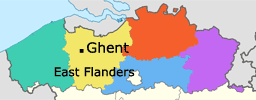 During the later Middle Ages Ghent became one of the largest and richest cities of northern Europe. Much of the city's medieval architecture remains intact and is well preserved and restored. A short walk through the present city center and a look at the three towers of Ghent, will convince any visitor of the past importance of this Flemish city. Ghent now is the capital of the Province of East-Flanders. During the later Middle Ages Ghent became one of the largest and richest cities of northern Europe. Much of the city's medieval architecture remains intact and is well preserved and restored. A short walk through the present city center and a look at the three towers of Ghent, will convince any visitor of the past importance of this Flemish city. Ghent now is the capital of the Province of East-Flanders.
One of history's pivotal figures. Charles V, the Holy Roman Emperor, was born in Ghent in 1500.
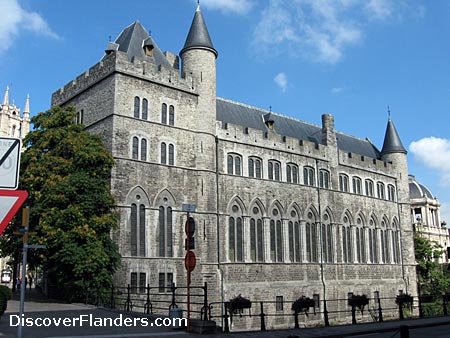
|
Castle of Gerard the Devil |
|
Most of Ghent's historical monuments are located on an axis that runs west to east through the center of the city.
We will start our journey on the Eastern end with the Castle of Gerald the Devil, going towards Saint Michael's Church on the Western end.
The Castle of Gerald the Devil, is now used by the city administration of Ghent for storage of the archives. It dates from the 13th century. It is the first really impressive building of our journey through Ghent.
Saint Bavo Cathedral (Sint Baafs Kathedraal)
Saint Bavo was consecrated in 942. Parts of the original structure and Romanesque style expansion can still be seen in the present day crypt of the cathedral.
Most of the present day Saint Bavo Cathedral was built from the 14th till the 16th century, in the Gothic style of that era. Saint Bavo became a cathedral in 1559, when the doicese of Ghent was founded. It is also the church where Charles V was baptized.
The cathedral is home to one of the artistic masterpieces of Flanders : the Ghent Altarpiece, better known as the Adoration of the Mystic Lamb, painted by Hubert and Jan van Eyck. The work is now being restores (once again). You can see the dismantled original piece, while a splendid complete copy of the work can also be admired. The painting has quite an interesting history. During both world wars in the 20th century, it was stolen and moved about Europe quite a bit.
The altarpiece consists of 24 compartmented scenes, which make up two views, open and closed. One of the panels was stolen in 1934, and has never been found.
Saint Bavo Cathedral lies on the eastern Side of Saint Bavo Square. On the western side of the square the Belfry and the Cloth Hall are located. On the northern side of the square we find the Royal Dutch Theatre.
Belfry
The 91-meter-high belfry of Ghent is one of three medieval towers that dominate the old city center of Ghent, the other two being Saint Bavo Cathedral and Saint Nicholas' Church, on opposite sides of the belfry.
The belfry of Ghent was constructed between 1313 and 1380. The famous bell of the tower, named Roeland, was used to warn citizens of any approaching danger from outside the city walls. Attached to the belfry is the Cloth Hall, which was erected between 1425 and 1445.
The Cloth Hall and the Belfry can be visited. A walk up the many stairs of the Belfry is a must to see the carillon and get a splendid view over the surrounding area.
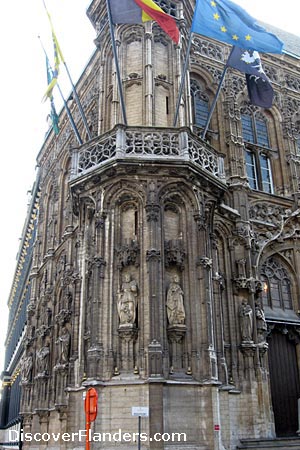 |
| One of the corners of the Town Hall in Ghent |
|
Just north of the Belfry (on the other side of a small square) lies the Town Hall of Ghent. It is in urgent need of renovation (at least on the outside) but one can see interesting sculptures similar to the ones on the town halls in Bruges and Leuven. The Town Hall was constructed and changed many times over the centuries, from the 15th century till present times.
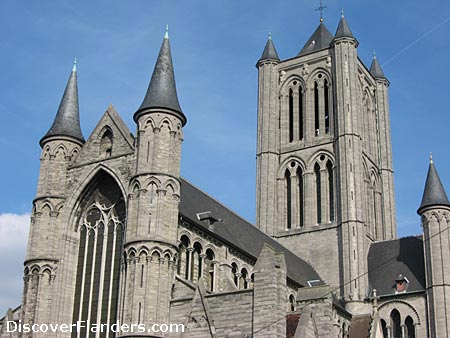 |
| Saint Nicholas' Church, Ghent |
|
Saint Nicholas' Church
Saint Nicholas' Church is built in the local gothic style from the beginning of th 13th century. The church has been extensively renovated over the last 30 years or so. One of the showpieces of the church is its organ dating from the middle of the 19th century. The are also two massive stained-glass windows by J.B. Capronnier, also dating from the middle of the 19th century, and now splendidly restored.
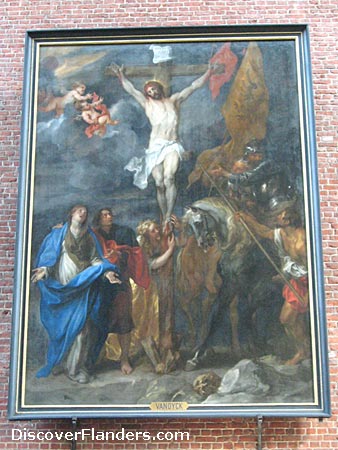 |
| Christ dying on the cross by Anthony Van Dyck, in the Saint Michael's church. |
|
Saint Michael's Church
After earlier construction on the site, the larger church was constructed over a long time period, starting from 1440. The church has a neo-gothic interior. It houses a famous painting by Anthony Van Dyck : Christ dying on the Cross.
Saint Michael's Bridge
Saint Michael's Bridge is located adjacent to the Saint Michael's church. It is a very good spot to get an overview of what Ghent has to offer. Looking towards the city center, one can observe the three towers of Ghent : The Saint Nicholas' church, the Belfry and the Saint Bavo Cathedral.
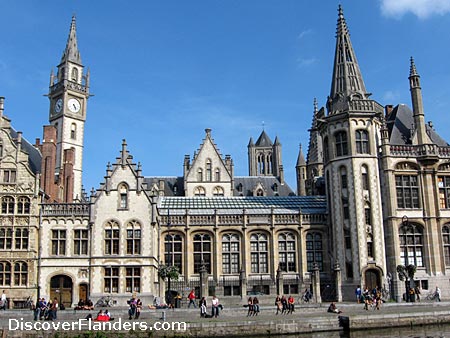 |
VIew over part of the Korenlei, Ghent
Visit picture gallery of the Korenlei in Ghent. |
|
Looking left when having your back towards the Saint Michael's church, you can see the Grasle' and Koornlei, two streets alongside the Leie river. The riverside is bordered by some architectural marvels, and is a good place to take a rest, and hang out for a while, maybe while enjoying a meal or drink at one of the restaurants. Just in front of Saint Michael's bridge is the Post-Office of Ghent. It is a neo-gothic building constructed at the beginning of the 20th century.
Walking 400 meters north on the Graslei, one arrives at the Grand Butcher's Hall (Vleeshuis), which dates from the 15th century. It now functions as a centre for the promotion of local East Flemish products, with some restaurants inside and special Ganda Hams hanging from overhead beams.
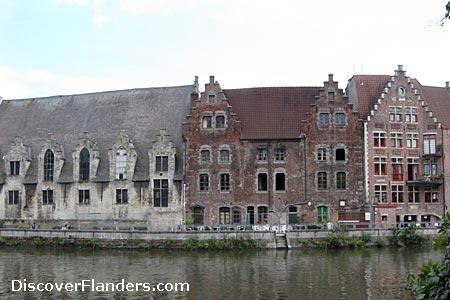 |
| A view across the river : The Butchers' Hall is seen on the left |
|
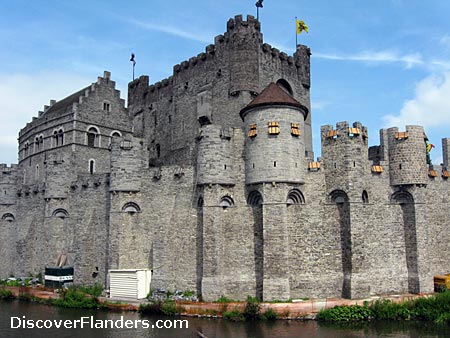 |
Gravensteen Castle in Ghent
Visit picture gallery of the Gravensteen Castle and the House of Alijn. |
|
The Gravensteen Castle and Patershol
The Gravensteen Castle is located on the other side of the river from the Grand Butcher's Hall.
The Gravensteen Castle was built from 1180 by count Philip of Alsace. It served for a long time as the seat of the Counts of Flanders until the 14th century. In later centuries it was used for various purposes : as a courthouse and as a prison. At one time, it was scheduled to be demolished. Now restored, it is a quite impressive building and houses a museum, with various torture devices. Admission does not come cheap at 8 Euro a person.
The Patershol is a network of little old streets that stretches out over a surface of about 4,5 ha. Patershol was at one time the quarter of the lower classes, inns and brothels. After the Second World War it' was renovated (old houses were demolished, new ones were built) and now, the Patershol is famous for its many trendy restaurants.
House of Alijn
Located just a little bit east from the Gravensteen Castle, the House of Alijn is a splendid building now housing the Museum of Folklore, where you can go back in time and see wonderfully recreated interiors showing how ordinary people in Ghent lived in days gone by. The House of Alijn formerly was a charity institution or hospice where old and needy women could spend the last years of their life.
|